You know that the issue of a new approach to boatbuilding that is more sustainable is a big one. As much as we sailors like to convince ourselves that we love nature and chose the sailboat over the power boat because of being underway driven by the power of nature in a “green” way, as much we have to accept that the GRP made boats are a huge, huge chunk of single-use plastic, require a lot of energy to make and produce an awful lot of garbage. There are, of course, many efforts to become greener, both undertaken by the big players as well as small entrepreneurs and visionaries. One of the ways out is an (almost) complete abandonment of plastic as the principal building material – and the utilization of wood.
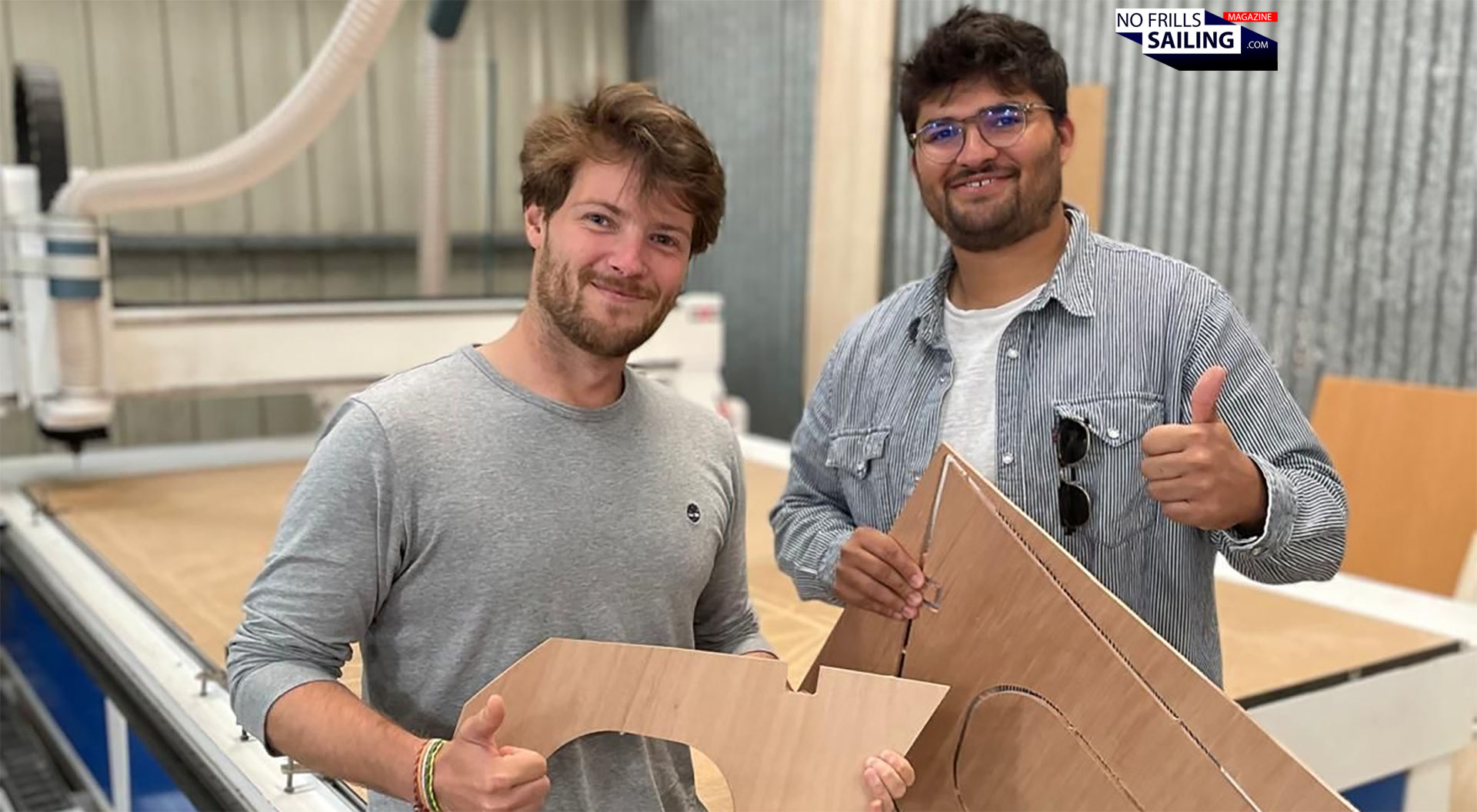
I´ve dedicated a whole series of articles to the topic as I find this highly, highly interesting. One of the stories in this matter is the development of wooden racing yachts in France. From an IMOCA 60 for Marc Thiercelin to be showcased at the Vendée Globe to the smallest, the Classe Mini 650, these guys want to prove that wooden boats can indeed cope with the harshest environments and stand their ground in the toughest regattas of the world. In this I´ve met young naval architect and asiring sailor Yannick Eudeline to talk about the “Greenscow”-project. A Mini 650 made from wood that is in the building shed right now.
Talking to Yannick Eudeline about the Greenscow-build
Lars Reisberg | NO FRILLS SAILING.com: “Yannick, I have seen that the Greenscow 650 is now under construction. Tell me how does it feel as a designer to see a project that once started with a pencil and a scribble becoming reality?”
Yannick Eudeline: “Lars, I tell you, it’s a special feeling, especially considering that this is really my first design. And even more so because … I’ll be the skipper! It’s a mix of stress, pride, joy and doubt. But above all, it’s the excitement of seeing the lines of the boat take shape, of putting your hands on an object that, until then, had only existed in my head. You can always say to yourself “I could have done this reinforcement differently, used this type of wood rather than another…”. You can always do better, and that’s a feeling you have to manage. The “better” will be for the next boat!”
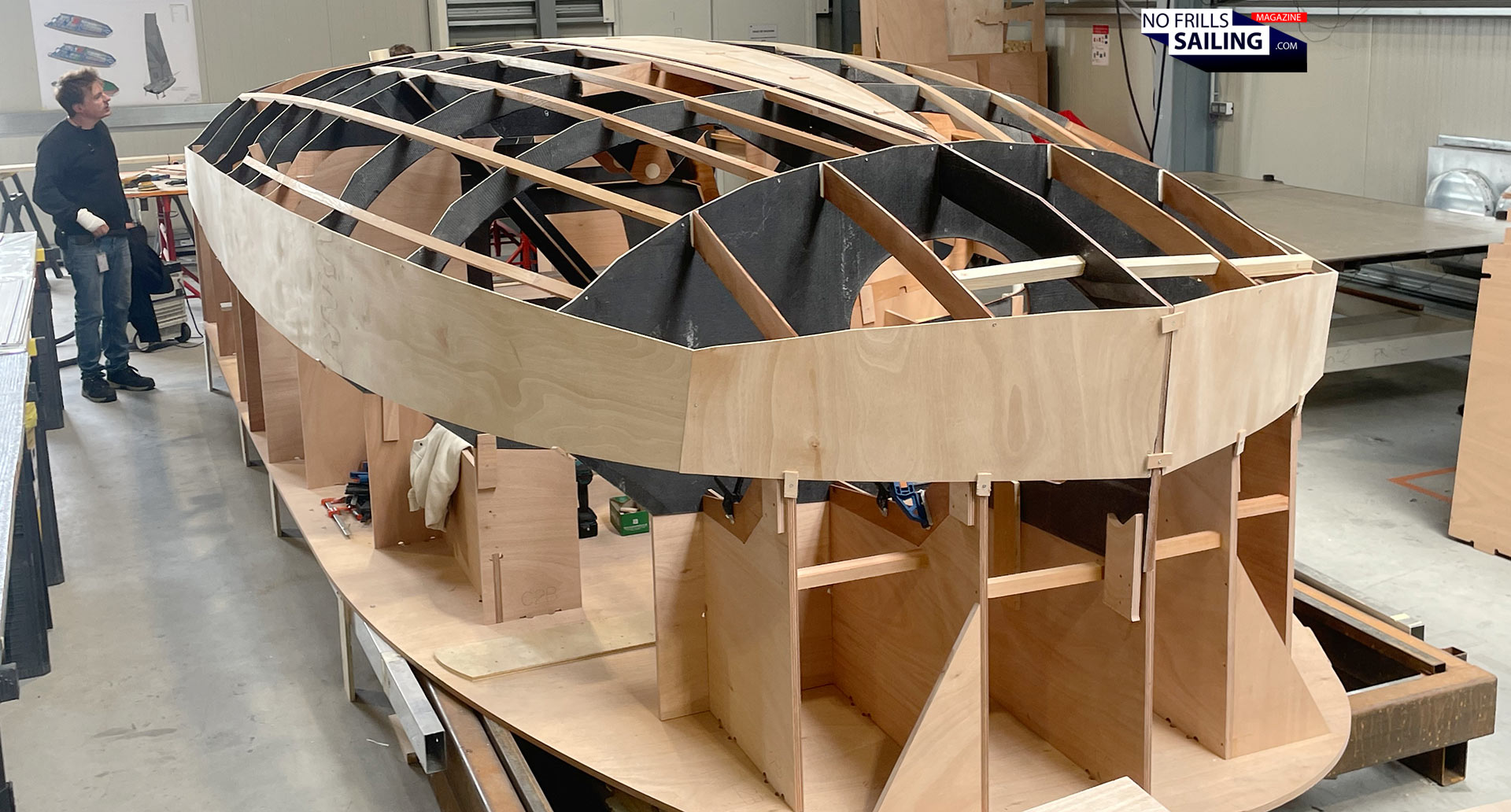
Lars Reisberg | NO FRILLS SAILING.com: “Oh wow, I didn´t knew that you will be sailing her. This adds some more spice to the whole project! So, let´s start easy: This boat is pretty special, as its name suggest “Green” meets “Scow” – what´s the idea behind this boat and how was it born?”
Yannick Eudeline: “The idea of the Greenscow 650 was born from the convergence of two dynamics, I´d say. For several years now, the desire to take part in the Mini-Transat has been growing in my mind. During my naval architecture studies, I began sketching out the first lines of my ideal boat. Later, while working with Gildas Plessis and Raphaël Gillet, the project became concrete. Together, we revisited Gildas Plessis’ preliminary work from 2012 on designing a scow-type IMOCA in plywood, the boat you´ve been writing about as well. The framework of the 2015 Paris Agreement was very present in our minds, and we aimed to challenge the barriers to using natural fibers in offshore racing. The studies conducted showed not only the technical viability, but also significant gains in terms of environmental impact. How much less impactful could an eco-designed offshore racing yacht be? Heavier? More or less performant? Our studies – focused on IMOCA, Class40, and of course, the Mini 6.50 – revealed no major obstacles that would justify a No-Go. The construction techniques we examined allow for powerful, versatile hull shapes. When optimized for their strengths, the materials offer highly interesting mechanical properties, to say the least.”
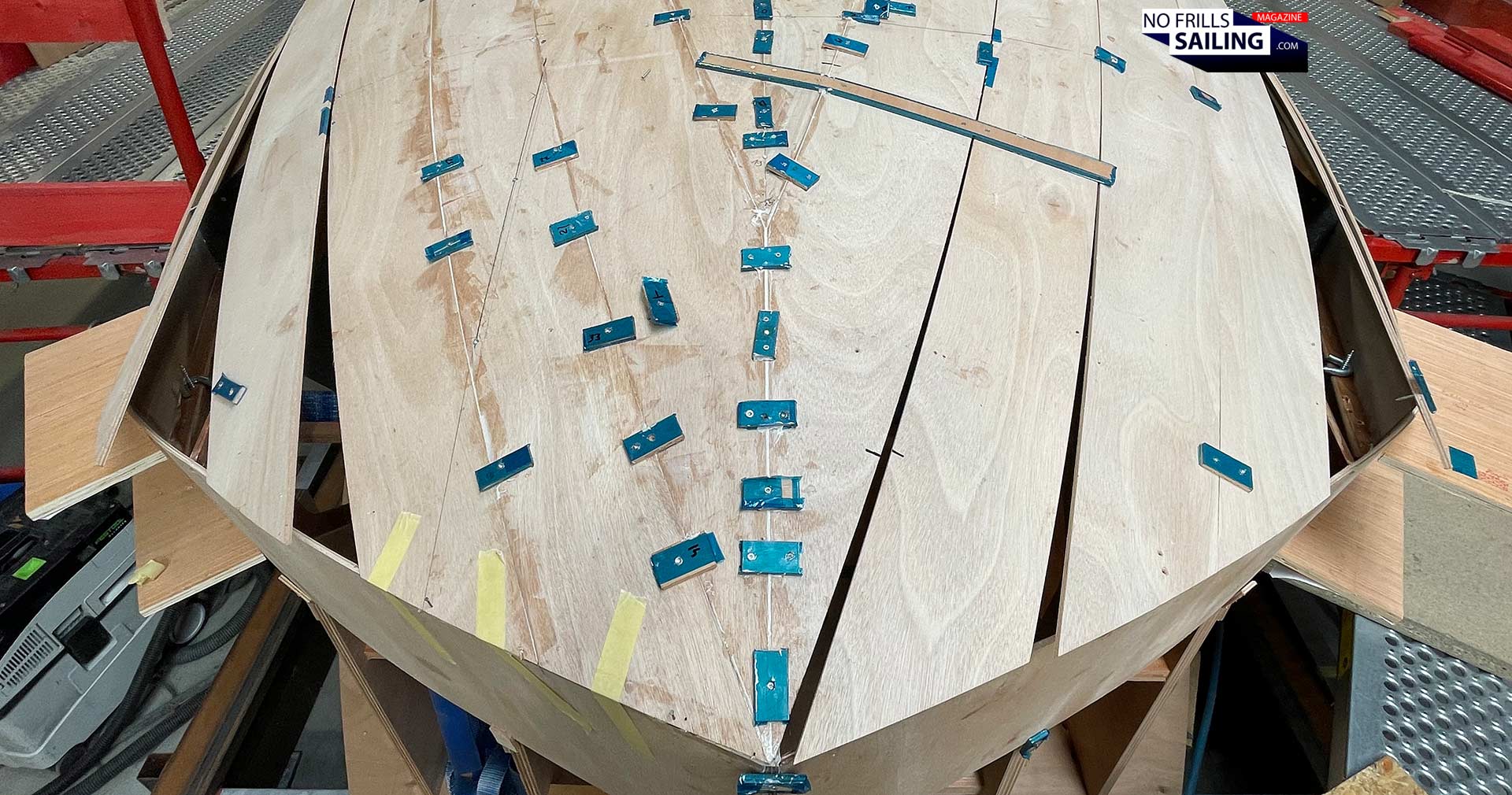
Lars Reisberg | NO FRILLS SAILING.com: “… so the idea was to reduce the environmental impact when making the boat, right?”
Yannick Eudeline: “It was one of the main goals, yes. Our studies showed that depending on the class and the materials allowed, the environmental gains vary: The impact reduction is enormous when carbon fiber composites are replaced with natural fibers for example, and still significant when replacing fiberglass. For the Greenscow 650, we expect to reduce the carbon footprint by a factor four on the whole boat, and by a factor twenty on the entire structured hull.
Lars Reisberg | NO FRILLS SAILING.com: “I am very interested in wooden boatbuilding and look at very many different projects. Can you tell me more about the timber that is used to build it? Is it special wood? Which kind of wood is used? Is the wood especially treated or is it the normal plywood we could buy in any dedicated show as well?”
Yannick Eudeline: “Most Greenscow units are built using derivatives of traditional woods. That´s mostly Okoumé or Red Cedar for example. However, they differ from common materials due to the optimizations they undergo. Marine-grade plywood with thin ply is used to enhance mechanical properties and resistance to the marine environment. The choice of wood species lies at the heart of the trade-offs we must make between mechanical performance, density, natural rot resistance, and supply chain logistics. We are particularly vigilant on this last point. Our current suppliers guarantee a very high level of traceability and the shortest possible supply routes. They comply with the most stringent certifications in terms of biodiversity impact, processing methods, and socio-economic responsibility.
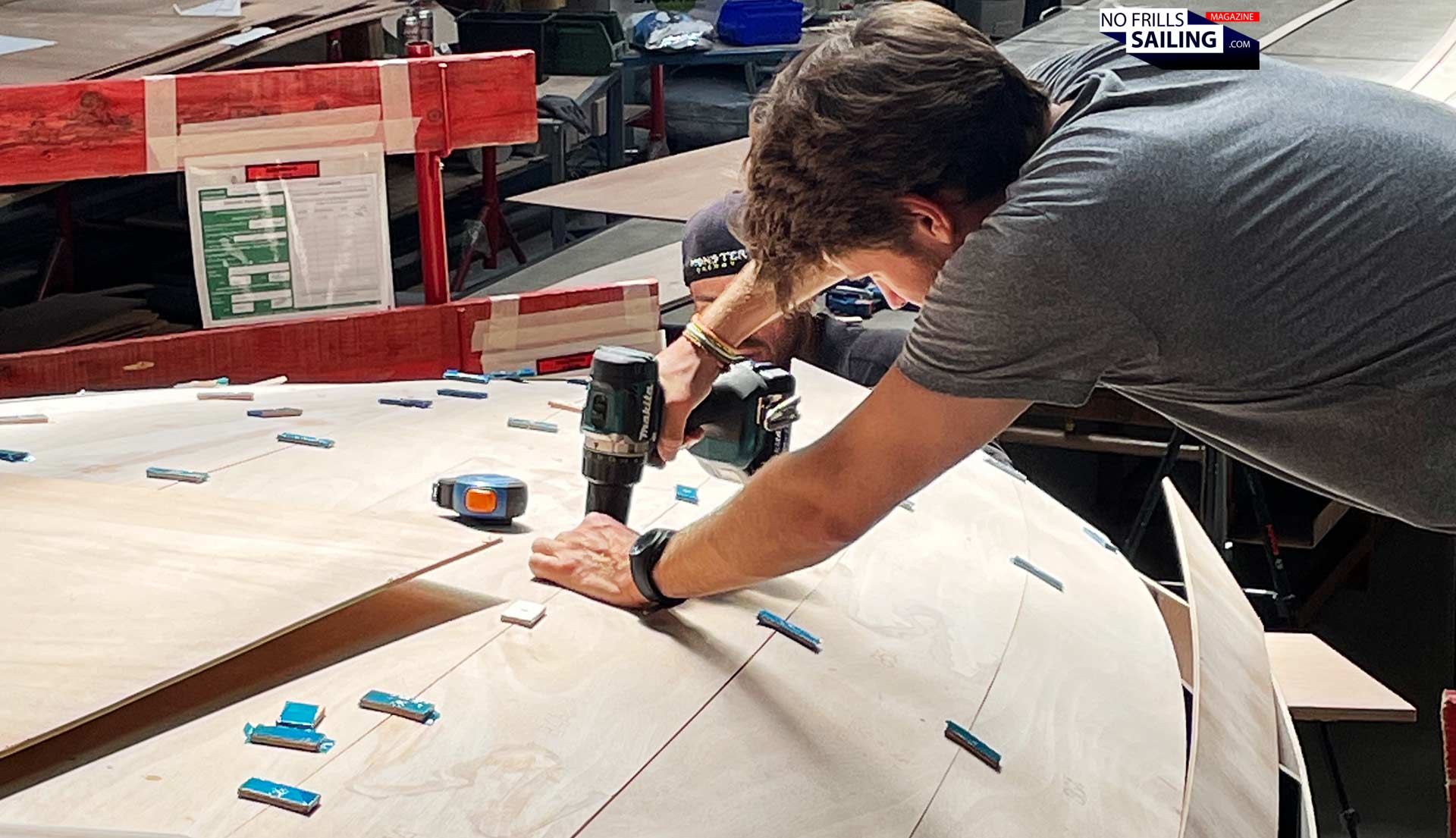
Lars Reisberg | NO FRILLS SAILING.com: “The boat is now in the shed under construction. How is the principal building process like? Cold moulding or do they start with the bulkheads, adding stringers and later the hull-plates?”
Yannick Eudeline: “You’re absolutely right. We use moulds for assembling the hull structure on a cradle. This cradle, made from wood-based materials, serves as a guide for positioning the structure. When well designed, it can be reused for building more boats. The simplicity, speed, and materials involved immediately convinced us that this is the right method to adopt in the Greenscow approach.
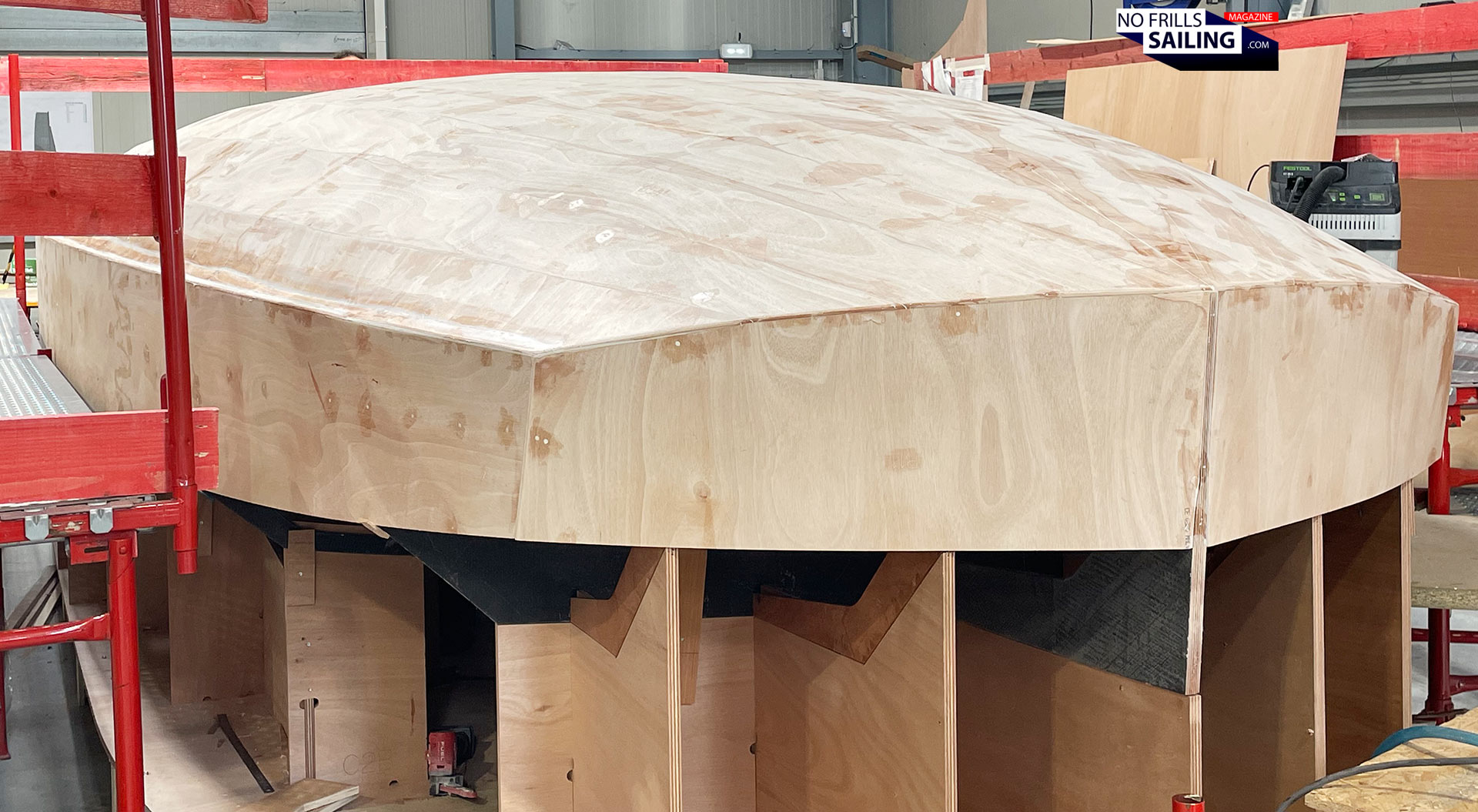
Lars Reisberg | NO FRILLS SAILING.com: “How are the different parts connected? Screws or nails? Or Epoxy-based glue?”
Yannick Eudeline: “So, there are many techniques for positioning or holding the various pieces of the puzzle in place. For example, we temporarily screw the hull planking to the structure while bonding with epoxy. Later the screws are taken out. Most of these techniques are time-consuming, especially on the 650, which features very thin planking. That’s why we work with shipyards renowned for their craftsmanship, such as Kaori Concept and Duqueine Atlantique. Today, we use advanced bio-based resins and hardeners available from our suppliers, in order to further reduce our consumption of fossil resources.”
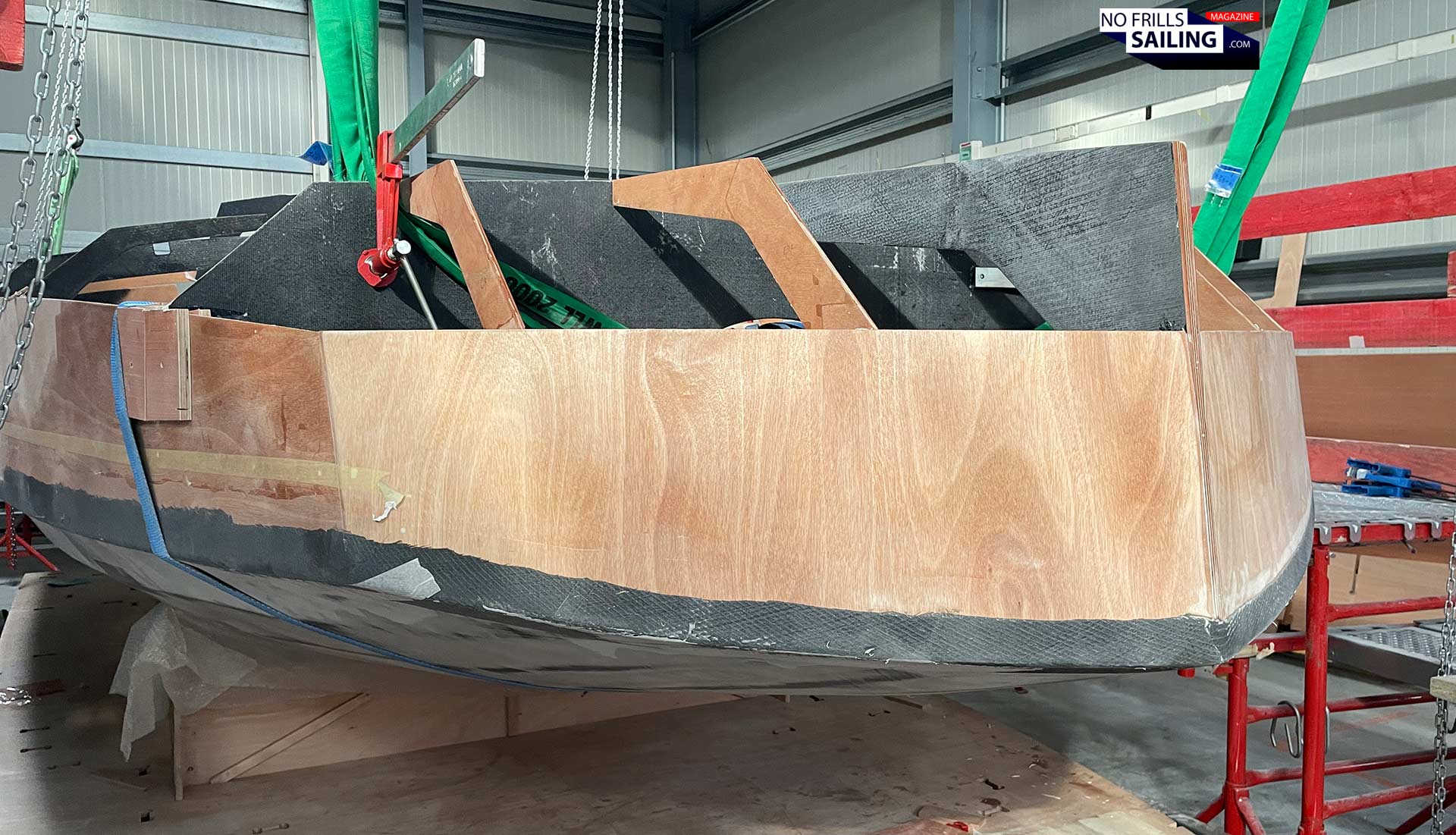
Lars Reisberg | NO FRILLS SAILING.com: “Will the raw wooden hull be fitted with one or more layers of glass fiber as well?”
Yannick Eudeline: “Yes. That´s important to for impact protection. We will cover the hull, the deck, the cockpit and the roof of the boat with a layer of fiber. But not the classic glass fibers. We chose basalt. We have conducted, and still conduct, a series of tests to characterize the performance of basalt fiber combined with plywood. The results are pretty strong: Basalt outperforms glass fiber in nearly every aspect! It also appears that Basalt has a lower footprint, which is why we chose it for the Mini.”
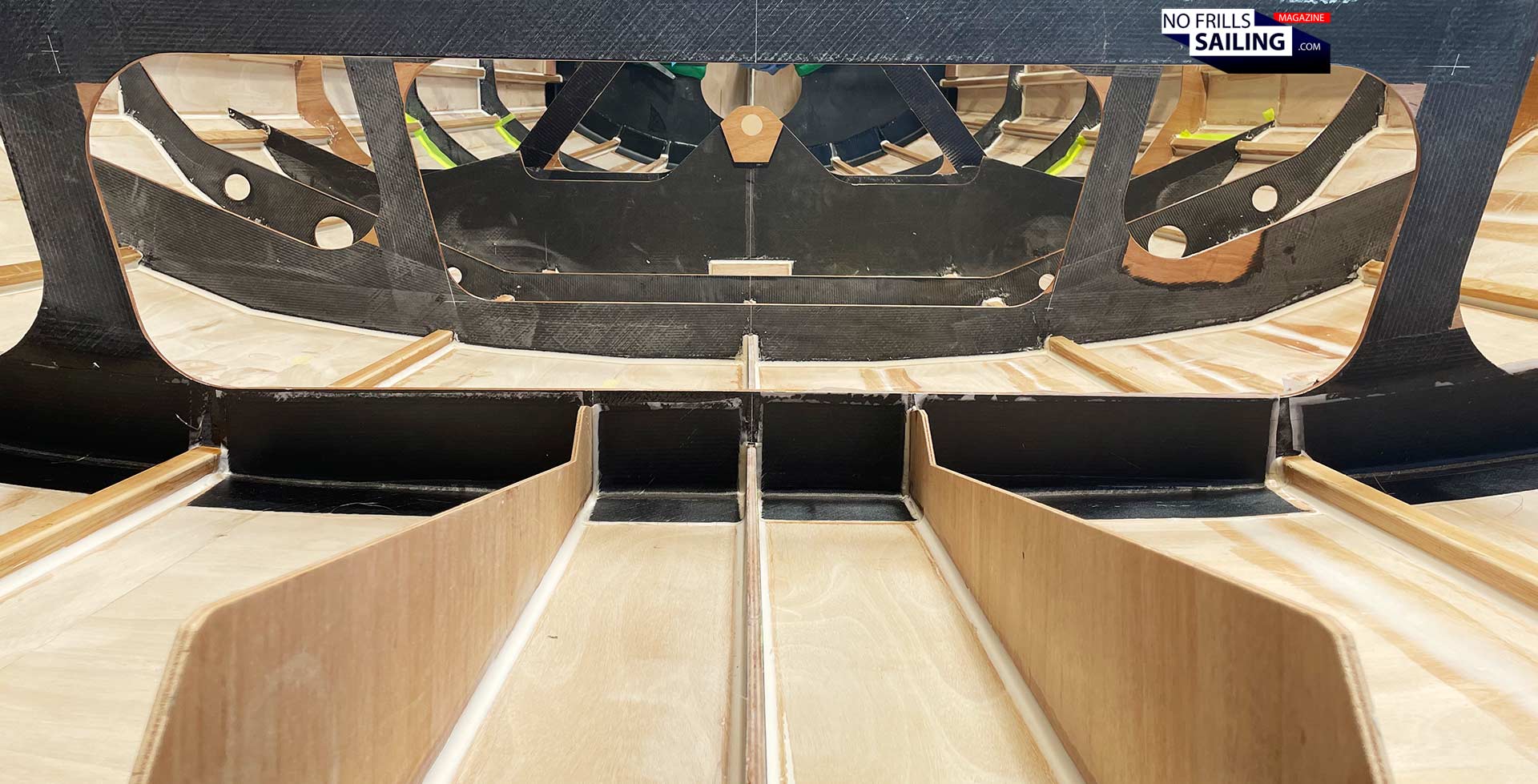
Lars Reisberg | NO FRILLS SAILING.com: “In general: What will the Greenscow 650 set apart mostly from her GRP-Mini-sisters? In terms of stiffness, weight, durability et cetera …?”
Yannick Eudeline: “I would day that the Greenscow 650 will stand out from other Minis for several reasons. First, the use of plywood requires developable shapes. We wanted a scow-type hull, but to achieve the very rounded bow shapes now common in Minis, we would have had to use strip-planking, a long and costly process that we ruled out. The idea was therefore to design a sharp arrow-shaped bow, allowing for a wide and powerful front with large rocker. And to be honest, the aesthetics are impressive. In terms of weight, the boat’s estimated displacement is slightly higher than that of a conventional carbon fiber Mini, but better than that of a series fiberglass boat.”
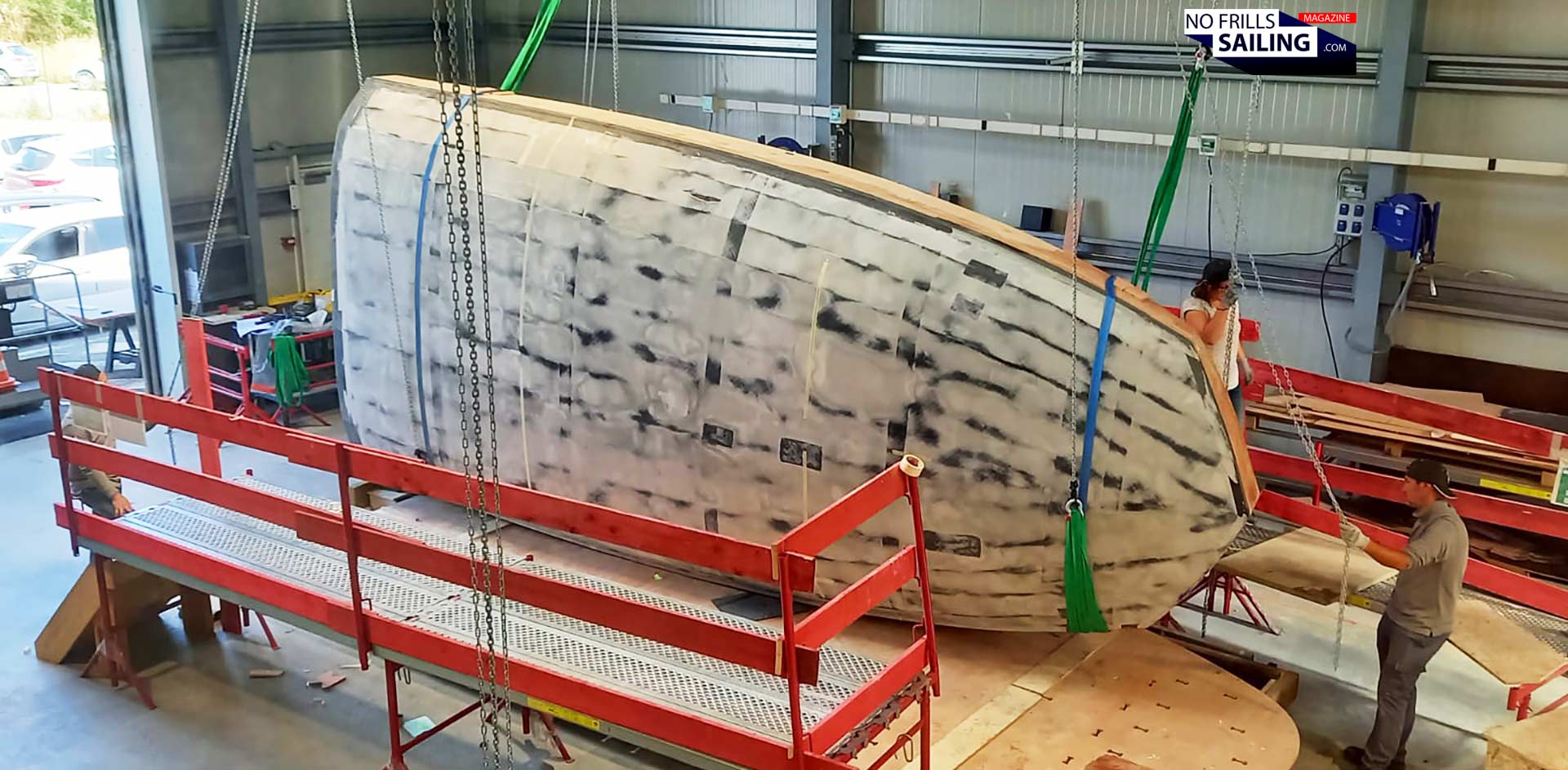
Lars Reisberg | NO FRILLS SAILING.com: “What are the next steps for this boat? When will she be finished and put to the water and what will be her first real test in racing-mode?”
Yannick Eudeline: “Well, ideally and depending on funding, I would like to put the boat on the water at the end of 2025 or early 2026. The first real race test would probably be the Plastimo Lorient Mini-race in 2026. That’s the goal for now, but the search for more funding is still ongoing. We will see. For now, we focus on the finishing of the boat.”
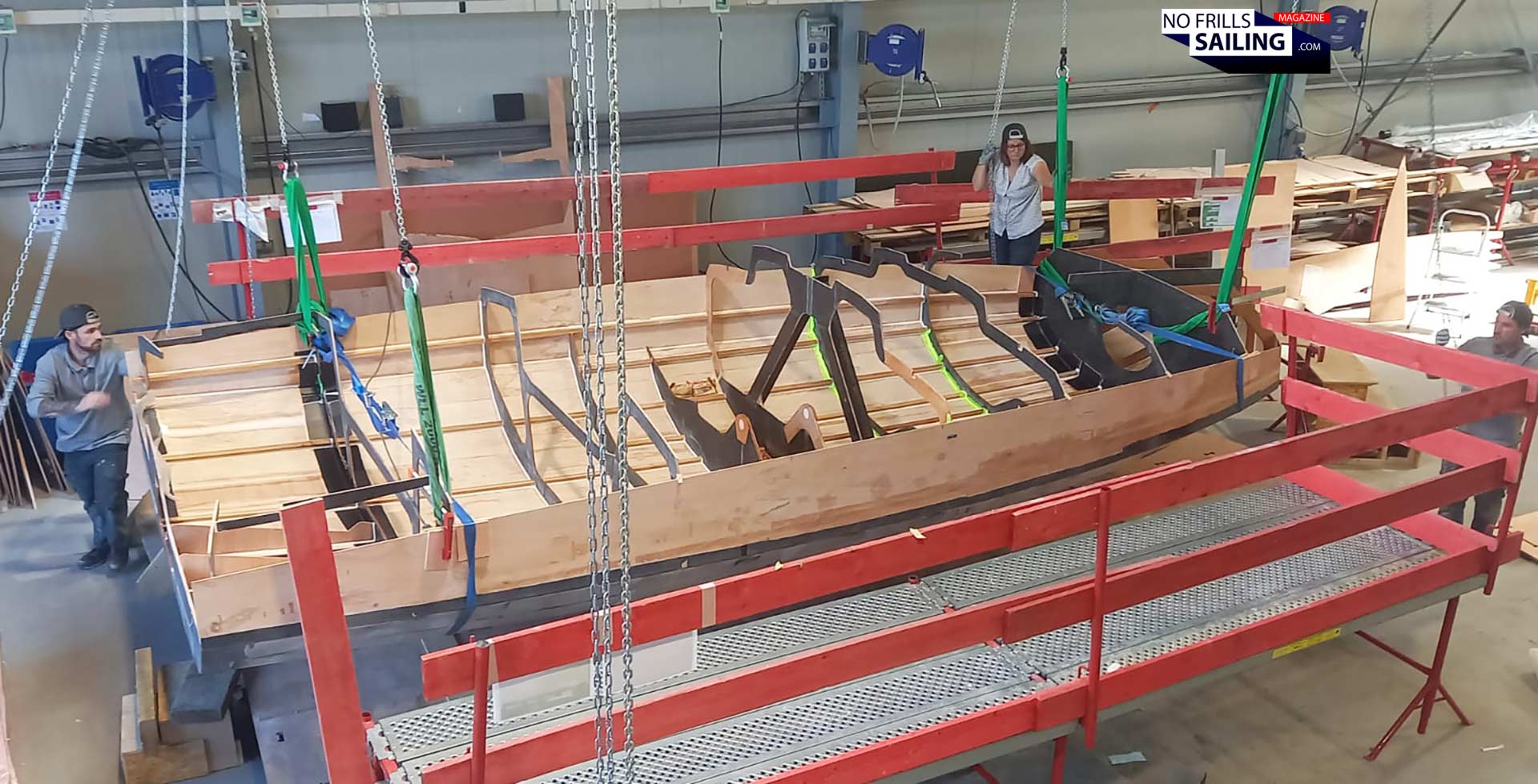
Thanks so much Yannick, and all the best for your amazing project! As we will keep in touch, I am very excited to watch the completion of your boat and can´t wait to see her in the water hopefully soon. And you, dearest reader, may not miss new any article from now on by subscribing to the monthly NO FRILLS SAILING.com-Newsletter.
Connected articles on more sustainable boatbuilding:
All articles on the #woodenfuture
For the large boatbuilders, even tiny steps make a huge impact
Look at this mountain of plastic!
